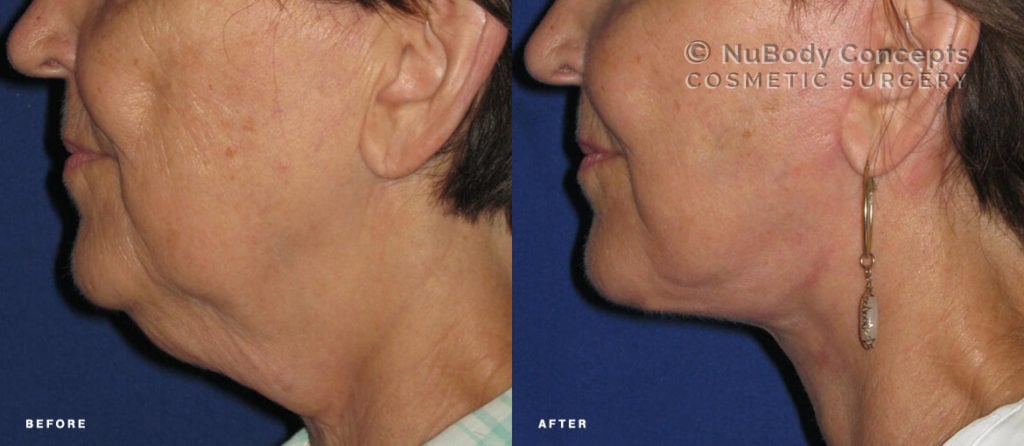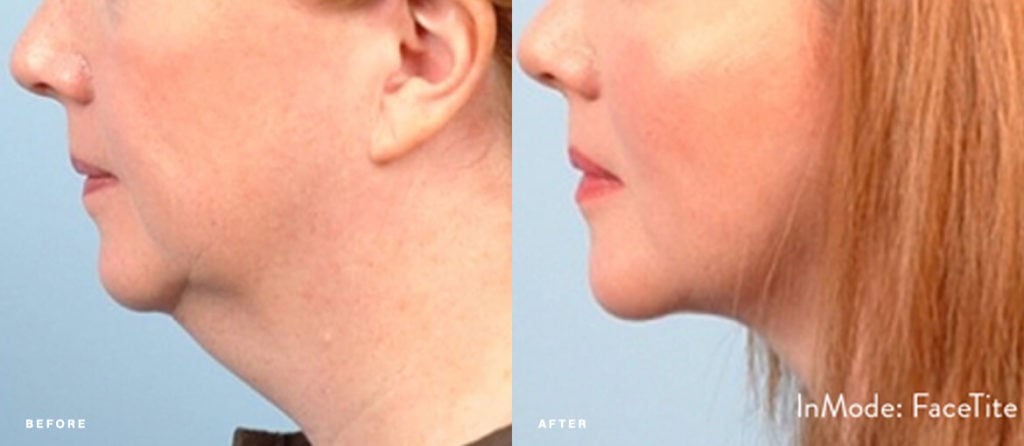
Medically reviewed by Dr. John Rosdeutscher – Written by Sine Thieme
A facelift involves surgery, whereas FaceTite is a less-invasive procedure that can achieve facelift-like results using radio frequency assisted skin tightening. Our cosmetic surgery teams at NuBody Concepts in Nashville and Memphis have helped hundreds of men and women rejuvenate their face and neck using either technique, or even a combination of both.
Read on to learn about the difference between a facelift and FaceTite as well as pro and cons of each treatment.
FaceTite vs Traditional Facelift


FaceTite (same as BodyTite) by inMode uses Radio Frequency Assisted Lipolysis to tighten the skin without the need for surgery. For this reason it is also referred to as a non-surgical facelift. While technically a FaceTite procedure still qualifies as surgery, in reality it is very different from the surgery you might associate with a facelift in the traditional sense.
A traditional facelift uses exisional surgery. This means a plastic surgeon uses a scalpel to make incisions in the skin, pulls the skin tight to remove any sagging or drooping, and reattaches it by placing sutures in an inconspicuous area. This is a great technique to achieve the best and most long-lasting rejuvenation results, since the surgeon can mold the contours precisely to the desired aesthetic outcome.
The downside, however, is the resulting scar – even though it is typically well hidden along the hairline – and a longer recovery to allow for proper wound healing. Procedures with surgical incisions also tend to have a slightly higher inherent risk, and they tend to also be more expensive.
This is the advantage of FaceTite over a facelift: other than a few tiny marks where the thin cannula is inserted under the skin, it requires no incisions or sutures. No skin is cut off at all – it is simply contracted to achieve a tighter look. Particularly in the lower face and neck area, this method can achieve a big and lasting rejuvenation effect without the recovery hassles of surgery.
How FaceTite Works
As mentioned above, FaceTite uses radiofrequency (RF) energy to melt away fat cells under the skin. This “coagulation” tightens the connective tissues and leads to skin contraction from 35% to 45%. It does not require a scalpel and avoids permanent scarring. The plastic surgeon is able to deliver the RF energy with a thin wand that is inserted through tiny, strategically-placed incisions in the skin.
FaceTite is often preceded by a round of liposuction to remove excess fat if necessary. The incisions can be used for both wands, so this is a very economical way to achieve even better results.
Watch the below video to understand how FaceTite works:
Pros of FaceTite
- Minimally-invasive
- Fast and easy recovery
- Low-risk
- Skin Contraction up to 45%
Cons of FaceTite
- Cannot handle excessive amounts of sagging skin
- Results improve over time, meaning the end result is not always immediately visible
Areas of Application
- Sagging jowls
- Sagging neck
- Undefined jawline
- Wrinkles and fine lines in lower face
- Double chin or fullness below the chin
- Marionette lines around the mouth
- Decreased collagen and elastin production of the skin
How a Facelift Works
On the day of your facelift procedure, you will receive a local anesthetic combined with IV sedation for maximum comfort. The level of your IV sedation (i.e. how “awake” you can be) is something you will discuss in your personal consultation prior to your surgery. You will also discuss any customizations, such as adding a round of FaceTite to the neck, or even a brow lift or eyelid surgery.
During the surgery, the doctor makes an incision that will later blend into the hairline following the natural contours around the ear and below the jawline. He or she excises any sagging skin or tissues, then pulls the remaining skin tight and reattaches it.The entire procedure takes approximately 2 hours. Wound healing typically takes between 3 to 5 days, with the scar fading over time for up to a year. Your “social recovery” may last longer than 5 days, depending on the level of swelling and bruising – a normal side effect of any surgery.
Pros of a Facelift
- The surgeon can make very precise alterations to achieve the desired results
- Results are seen immediately after surgery (once post-op swelling has subsided)
- Excess skin can be removed
Cons of a Facelift
- Most invasive type of facial procedure
- Longer recovery to allow for proper wound healing
- Though well disguised, leaves a permanent scar or scars
Areas of Application
- Remove excess skin
- Smooth out folds or wrinkles
- Lift and restore facial tissues of mid and lower face
- Tighten cheeks
- Re-outline a sagging jawline
- Lift a sagging neck
Should You Have a Facelift or FaceTite?
No one procedure fits every patient. Whether a facelift or skin tightening with FaceTite is better for your circumstances depends entirely on your aesthetic goals as well as your tolerance for downtime.
If you have a mild to medium amount of sagging but otherwise healthy, still elastic skin, FaceTite can achieve surprisingly good results that simply weren’t possible with previous technologies. Especially if you are on a tight time budget and want to return to work or regular activities without much delay, FaceTite is for you.
If your skin has lost a lot of elasticity – most often in older patients – and there is a medium to large amount of sagging, a facelift may be needed to get you the results you are looking for. In many cases the two procedures are not mutually exclusive but can be combined to achieve the best overall results.
To learn more about both procedures and get expert advice on the pros and cons of each in your individual circumstance, it’s best to consult with a plastic surgeon experienced in facial rejuvenation. If you are ready to get started, use the pink button to schedule a consultation with our board-certified plastic surgeon in Nashville or Memphis.












